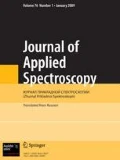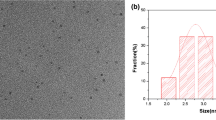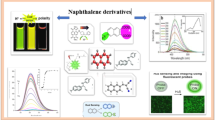A new synchronous fluorimetric method for the analysis of bisphenol A has been developed based on procaine hydrochloride as a self-quenching fluorescence probe. In acidic solution, procaine hydrochloride could be diazotized with sodium nitrite; then the diazotized product could react with bisphenol A in NH3–NH4Cl buffer and produce the quenching of fluorescence of diazotized procaine hydrochloride-NH3–NH4Cl solution. Based on this observation, an inhibitory fluorimetric method is reported for the determination of trace bisphenol A. The synchronous spectral peaks of the reaction system are at 225 and 270 nm. The spectra of the two peaks can be separated, and bisphenol A can be determined directly. The possible mechanism of the reaction has also been discussed. Under optional conditions, bisphenol A can be determined over the concentration range of 0.10 to 1.4 μg/mL with a correlation coefficient of 0.99. The detection limit is 0.04 μg/mL at a signal-to-noise ratio of 3. The relative standard deviation (RSD) for 11 repetitive determinations of 1.0 μg/mL b isphenol A is 0.32%. The utility of this method was demonstrated by determining bisphenol A in hot water in contact with commercially available table-water bottle samples.
Similar content being viewed by others
References
R. B. P. Vidal, G. A. Ibañez, and G. M. Escandar, Talanta, 143, 162–168 (2015).
Y. Zhu, C. Zhou, X. Yan, Y. Yan, and Q. Wang, Anal. Chim. Acta, 883, 81–89 (2015).
A. Kim, C. R. Li, C. F. Jin, K. W. Lee, S. H. Lee, K. J. Shon, N. G. Park, D. K. Kim, S. W. Kang, Y. B. Shim, and J. S. Park, Chemosphere, 68, 1204–1209 (2007).
S. Rodriguez-Mozaz, M. L. de Alda, and D. Barceló, Water Res., 39, 5071–5079 (2005).
Y. Watabe, T. Kondo, M. Morita, N. Tanaka, J. Haginaka, and K. Hosoya, J. Chromatogr. A, 1032, 45–49 (2004).
J. Poskrobko, M. Dejnega, and M. Kiedik, J. Chromatogr. A, 883, 291–297 (2000).
Y. Sun, M. Wada, O. Al-Dirbashi, N. Kuroda, H. Nakazawa, and K. Nakashima, J. Chromatogr. B, 749, 49–56 (2000).
M. Rezaee, Y. Yamini, S. Shariati, A. Esrafili, and M. Shamsipur, J. Chromatogr. A, 1216, 1511–1514 (2009).
M. Kawaguchi, R. Ito, N. Endo, N. Okanouchi, N. Sakui, K. Saito, and H. Nakazawa, J. Chromatogr. A, 1110, 1–5 (2006).
S. Wang, X. Wei, L. Du, and H. Zhuang, J. Lumin., 20, 46–50 (2005).
K. K. Reza, M. A. Ali, S. Srivastava, V. V. Agrawal, and A. M. Biradar, Biosens. Bioelectron., 74, 644–651 (2015).
L. A. Goulart, F. C. de Moraes, and L. H. Mascaro, Mater. Sci. Eng. C, 58, 768–773 (2016).
E. Mazzotta, C. Malitesta, and E. Margapoti, Anal. Bioanal. Chem., 405, 3587–3592 (2013).
T. Ndlovu, O. A. Arotiba, S. Sampath, R. W. Krause, and B. B. Mamba, Sensors, 12, 11601–11611 (2012).
Y. F. Zhuang, J. T. Zhang, and G. P. Cao, J. Chin. Chem. Soc., 55, 994–1000 (2008).
Y. F. Zhuang, M. Zhou, J. Gu, and X. M. Li, Spectrochim. Acta A: Mol. Biomol. Spectrosc., 122, 153–157 (2014).
Y. Li, J. Y. Xu, L. K. Wang, Y. J. Huang, J. J. Guo, X. Y. Cao, F. Shen, Y. Luo, and C. Y. Sun. Sens. Actuators B: Chem., 222, 815–822 (2016).
X. Wang, H. L. Zeng, Y. L. Wei, and J. M. Lin, Sens. Actuators B: Chem., 114, 565–572 (2006).
M. Del Olmo, A. Zafra, A. B. Jurado, and J. L. Vilchez, Talanta, 50, 1141–1148 (2000).
J. Fan, H. Q. Guo, G. G. Liu, and P. G. Peng, Anal. Chim. Acta, 585, 134–138 (2007).
O. M. Zharkova, Y. P. Morozova, and V. Y. Artyukhov, Russ. Phys. J., 48, 17–24 (2005).
Author information
Authors and Affiliations
Corresponding author
Additional information
Published in Zhurnal Prikladnoi Spektroskopii, Vol. 85, No. 6, pp. 971–977, November–December, 2018.
Rights and permissions
About this article
Cite this article
Zhuang, Y.F., Cao, G.P., Mao, J.Y. et al. Determination of Bisphenol A by Synchronous Fluorimetry Using Procaine Hydrochloride as Self-Quenching Fluorescence Probe. J Appl Spectrosc 85, 1094–1100 (2019). https://doi.org/10.1007/s10812-019-00764-x
Received:
Published:
Issue Date:
DOI: https://doi.org/10.1007/s10812-019-00764-x




